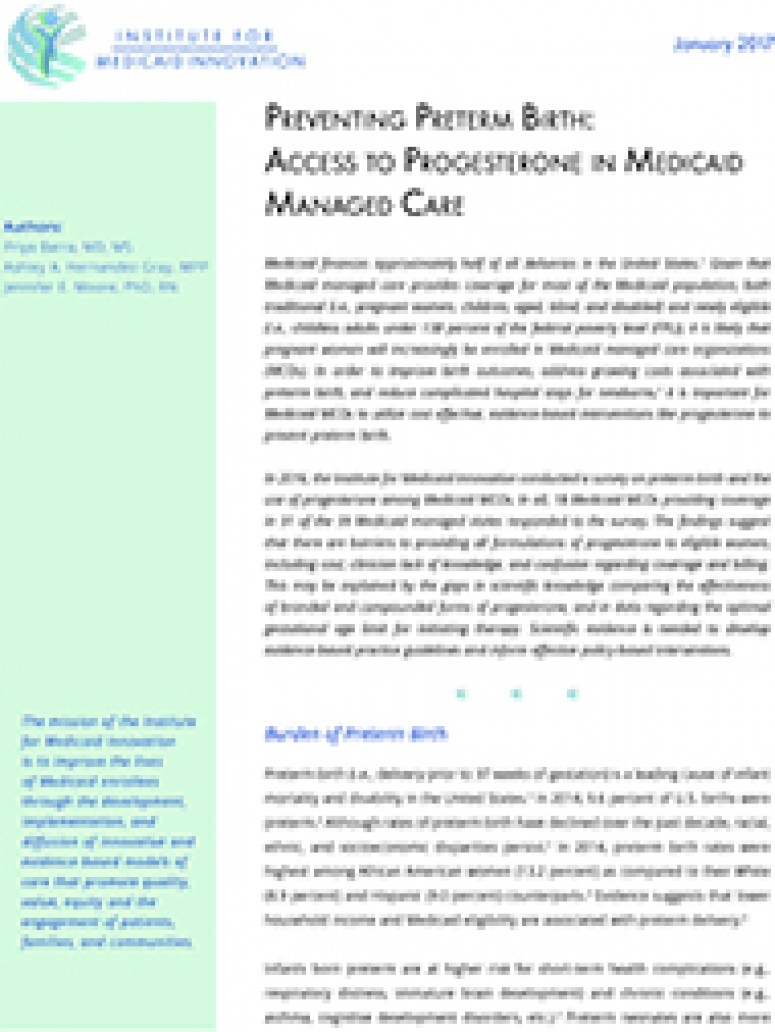Policy Solutions are Needed to Broaden Access to 17P to Prevent Preterm Births for Pregnant Women in Medicaid

Medicaid finances approximately half of all deliveries in the United States. A recent analysis conducted by A. R. Markus et. al. (2016) found that Medicaid covered approximately 48.8 percent of all preterm births (compared to 42.1 percent covered private insurance) from 2010-2013 and that Medicaid was 7.5 percent more likely to be the source of coverage for a preterm birth than private insurance. It is worth noting that this analysis did not stratify by delivery system (e.g., fee-for-service or managed care).
Currently, Medicaid managed care organizations (MCOs) provides coverage for most of the Medicaid population, both traditional (i.e., pregnant women, children, aged, blind, and disabled) and newly eligible (i.e., childless adults under 138 percent of the federal poverty level (FPL)). As a result, it is likely that pregnant women will increasingly be enrolled in Medicaid MCOs. In order to improve birth outcomes, address growing costs associated with preterm birth, and reduce complicated hospital stays for newborns, it is important for Medicaid MCOs to utilize cost effective, evidence-based interventions like progesterone to prevent preterm birth.
In 2016, the Institute for Medicaid Innovation, in partnership with the Robert Wood Johnson Foundation and Medicaid Health Plans of America (MHPA), conducted a survey of Medicaid MCOs to better understand progesterone coverage and barriers to accessing this medication. Medicaid MCOs were asked to identify resources that would help to support broader use of progesterone to prevent preterm birth. Their responses included the following:
- Clinician education/ Barriers to providing 17P may be reduced by improving clinician education on the use of progesterone, coverage of the drug in medical and pharmacy benefits, and the proper procedures for billing.
- Adoption of presumptive eligibility for pregnant women/ In order to get Medicaid-eligible pregnant women at risk for preterm birth the access to progesterone when it is most effective, eligibility pathways that expedite enrollment in Medicaid should be adopted, including presumptive eligibility for pregnant women.
- More specific evidence-based policies from CMS/ As new data emerges and further refines eligibility criteria and indications for progesterone, clear policies from CMS could provide guidance to states as they develop their formularies.
The report of this survey – the first to look nationally at progesterone coverage policies in a Medicaid managed care setting – also discusses possible solutions to improve access to progesterone among eligible women. The full results can be found here.
Sources:
Markus, A. R., Krohe, S., Garro, N., Gerstein, M., & Pellegrini, C. (2016). “Examining the association between Medicaid coverage and preterm births using 2010-2013 National Vital Statistics Birth Data.” Journal of children and Poverty. http://dx.doi.org/10.1080/10796126.2016.1254601
